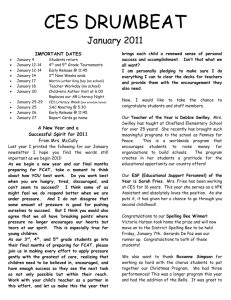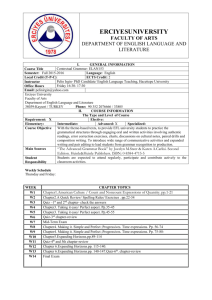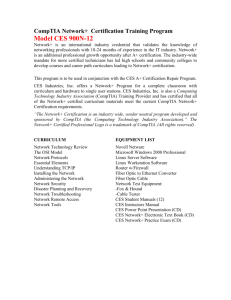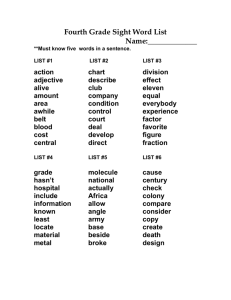Introduction to Physical Design of Transportation Facilities
advertisement
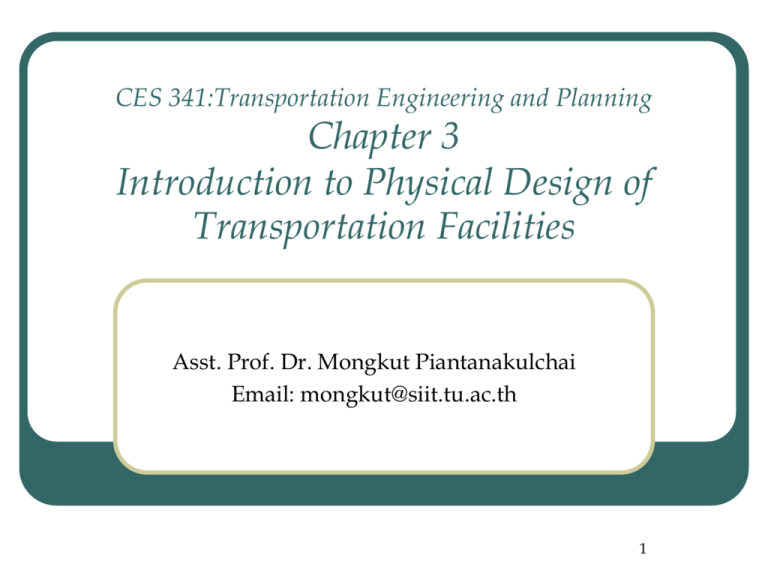
CES 341:Transportation Engineering and Planning Chapter 3 Introduction to Physical Design of Transportation Facilities Asst. Prof. Dr. Mongkut Piantanakulchai Email: mongkut@siit.tu.ac.th 1 3.1 The Design Process Overall process of transportation project development include •Technical elements •Legal elements •Political elements When carried out of public agency, it must balance the interest of stakeholders The Planning and Design process CES 341 Transportation Engineering and Planning Chapter3: Introduction to Physical Design of Transportation Facilities 2 3-1 The transportation facility design process CES 341 Transportation Engineering and Planning Chapter3: Introduction to Physical Design of Transportation Facilities 3 3.2 Design Standards Standards by type of facility • Highway– design standards by state DOT, recommended standards by AASHTO, FHWA • Railway – design standards by railroad company or transit authority, recommended standards by AREA • Air – design standards for airport landing areas by FAA (in the US), ICAO (for international level) Design standards should also consider human capabilities characteristics. In many cases, the design standard is based on comfort CES 341 Transportation Engineering and Planning Chapter3: Introduction to Physical Design of Transportation Facilities 4 Table 3.1: Relationships between vehicular and facility characteristics (1/2) Vehicular characteristics Related facility characteristics Length Park stall length Transit station platform length Width Lane width Parking stall width Lateral clearance Height Vertical clearance Minimum vertical curve length Wheelbase (turning radius) Lateral clearance on curves Intersection edge radii CES 341 Transportation Engineering and Planning Chapter3: Introduction to Physical Design of Transportation Facilities 5 Table 3.1: Relationships between vehicular and facility characteristics (2/2) Vehicular characteristics Related facility characteristics Weight Structural design of surface Structural design of guideway Structural design of bridges Acceleration/deceleration Maximum grade Minimum vertical curve length Horizontal curve radius Speed Horizontal curve radius Minimum vertical curve length Maximum superelevation Lift Runway length CES 341 Transportation Engineering and Planning Chapter3: Introduction to Physical Design of Transportation Facilities 6 3.3 Design Speed and Sight Distance Design speed (for highways): The maximum safe speed that can be maintained over a specified section of highway CES 341 Transportation Engineering and Planning Chapter3: Introduction to Physical Design of Transportation Facilities 7 Table 3.2: Recommended Design Speeds Conditions Design speed, km/h Limited access types Rural freeways in mountainous terrain Freeways in urban areas 80-100 100-110 Rural freeways, level terrain 110 Unlimited access types Rural arterials: Flat terrain 100-110 Rolling terrain 80-100 Mountainous terrain 60-80 Urban: Arterial streets 60-100 Arterial streets, central business districts 50-60 Source: Based on A Policy on Geometric Design of Highways and Streets. Copyright 1994 CES 341 Transportation Engineering and Planning Chapter3: Introduction to Physical Design of Transportation Facilities 8 Stopping Sight Distance (SSD) Stopping sight distance = distance required for vehicle to stop safely under assumed conditions (such as height of object, driver’s eye’s height, etc.) Stopping sight distance formula s d r db (3.1) s = stopping sight distance dr = perception-reaction distance db = breaking distance CES 341 Transportation Engineering and Planning Chapter3: Introduction to Physical Design of Transportation Facilities 9 Perception-Reaction Distance Perception-reaction distance formula d r vtr (3.2) dr = perception-reaction distance v = design speed tr = perception-reaction time AASHTO recommended conservative tr value of 2.5 sec for stopping decision CES 341 Transportation Engineering and Planning Chapter3: Introduction to Physical Design of Transportation Facilities 10 Breaking Distance Breaking distance simplified formula 2 v db 2g f G (3.3) db g f = breaking distance = acceleration of gravity = coefficient of friction between tires and pavement G = average grade, dimensionless ratio (m/m) CES 341 Transportation Engineering and Planning Chapter3: Introduction to Physical Design of Transportation Facilities 11 Breaking Distance For cases in which G varies (for instance, in a vertical curve), an average value for the entire break reaction distance is used) AASHTO also gives the mixed unit formula CES 341 Transportation Engineering and Planning v2 db 254 f (3.3a) db = breaking distance (m) v = design speed (kph) Note that the effect of grade is ignored in this formula Chapter3: Introduction to Physical Design of Transportation Facilities 12 Table 3.3: Coefficients of friction and stopping sight distances Design speed, km/h Coefficient of friction f Stopping sight distance, m 30 0.40 29.6-29.6 40 0.38 44.4-44.4 50 0.35 57.4-62.8 60 0.33 74.3-84.6 70 0.31 94.1-110.8 80 0.30 112.8-139.4 90 0.30 131.2-168.7 100 0.29 157.0-205.0 110 0.28 179.5-246.4 120 0.28 202.9-285.6 Source: Based on A Policy on Geometric Design of Highways and Streets. Copyright 1994 CES 341 Transportation Engineering and Planning Chapter3: Introduction to Physical Design of Transportation Facilities 13 Passing Sight Distance (PSD) Figure 3.2: Elements of passing sight distance CES 341 Transportation Engineering and Planning Chapter3: Introduction to Physical Design of Transportation Facilities 14 Table 3.4: Passing sight distances Design speed, km/h Passing sight distance, m 30 217 40 285 50 345 60 407 70 482 80 541 90 605 100 670 110 728 120 792 Source: Based on A Policy on Geometric Design of Highways and Streets. Copyright 1994 CES 341 Transportation Engineering and Planning Chapter3: Introduction to Physical Design of Transportation Facilities 15 3.4 Design Documents For Transportation Projects Bid documents Basic elements of standard plans • Plans • Specifications • Estimates • Plan • Profile • Cross section • Superelevation diagram CES 341 Transportation Engineering and Planning Chapter3: Introduction to Physical Design of Transportation Facilities 16 Figure 3.3: Highway plan view CES 341 Transportation Engineering and Planning Chapter3: Introduction to Physical Design of Transportation Facilities 17 Figure 3.3: Highway profile and superelevation diagram CES 341 Transportation Engineering and Planning Chapter3: Introduction to Physical Design of Transportation Facilities 18 Some technical terms Profile grade Stations Tangents Elevations Grades Cross-slopes Standard specifications, special provisions, general clauses, other clauses CES 341 Transportation Engineering and Planning Chapter3: Introduction to Physical Design of Transportation Facilities 19 Problem 3.1 Determine the minimum stopping sight distance on a *2.5% grade at a design speed of 90 km/h. CES 341 Transportation Engineering and Planning Chapter3: Introduction to Physical Design of Transportation Facilities 20 Problem 3.1 (solution) Total required stopping sight distance s dr db Reaction distance 1,000m km 2.5s 62.5m d r vtr 90km h 3,600s h Braking Distance f 0.30 (Table 3.3) G 0.025 (given) 2 1,000m km 90km h v2 3,600s h db 116.0m 2g f G 2 9.8m s 2 0.30 0.025 Total sight distance s dr db 62.5 116. 0 178.5 m CES 341 Transportation Engineering and Planning Chapter3: Introduction to Physical Design of Transportation Facilities 21 Problem 3.2 Determine the minimum stopping sight distance on a +1.5% grade at a design speed of 100 km/h. CES 341 Transportation Engineering and Planning Chapter3: Introduction to Physical Design of Transportation Facilities 22 Problem 3.2 (solution) Total required stopping sight distance s dr db Reaction distance 1,000m km 2.5s 69.4m d r vtr 100km h 3,600s h Braking Distance f 0.29 (Table 3.3) G 0.015 (given) 2 1,000m km 100km h v2 3,600s h db 129.1m 2g f G 2 9.8m s 2 0.29 0.015 Total sight distance s dr db 69. 4 129.1 198.5 m CES 341 Transportation Engineering and Planning Chapter3: Introduction to Physical Design of Transportation Facilities 23 Problem 3.3 Determine the minimum stopping sight distance on a *4.0% grade at a design speed of 70 km/h. CES 341 Transportation Engineering and Planning Chapter3: Introduction to Physical Design of Transportation Facilities 24 Problem 3.3 (solution) Total required stopping sight distance s dr db Reaction distance 1000m km 2.5s 48.6m d r vtr 70km h 3600s h Braking Distance f 0.31 (Table 3.3) G 0.04 (given) 2 1,000m km 70km h 2 3 , 600 s h v db 71.4m 2 2g f G 2 9.8m s 0.31 0.04 Total sight distance s dr db 48. 6 71. 4 120. 0 m CES 341 Transportation Engineering and Planning Chapter3: Introduction to Physical Design of Transportation Facilities 25 Exercise 3.1 Design standards link vehicle characteristics, human characteristics, and the characteristics of the transportation facility. What features of human and vehicle characteristics are important in the derivation of design standards? CES 341 Transportation Engineering and Planning Chapter3: Introduction to Physical Design of Transportation Facilities 26 Exercise 3.1 (Solution) Human characteristics that are important in the derivation of design standards include visual ability, ability to hear, reaction times, gap acceptance behavior, steering behavior, and the subjective sense of comfort. CES 341 Transportation Engineering and Planning Vehicular characteristics that are important in the derivation of design standards include physical dimensions (length, width, height, and wheelbase), weight (gross weight and wheel loads), acceleration and deceleration characteristics, maximum speed, and (for aircraft only) lift. Chapter3: Introduction to Physical Design of Transportation Facilities 27 Exercise 3.2 List and briefly describe at least five transportation facility characteristics typically specified by design standards. CES 341 Transportation Engineering and Planning Chapter3: Introduction to Physical Design of Transportation Facilities 28 Exercise 3.2 (Solution) Any five of the following: Minimum radius of horizontal curve. For a given design speed, minimum curve radius is limited by maximum allowable side friction, which is usually based on a comfort standard; maximum superelevation rate (or banking) for the curve; and the necessity to maintain stopping sight distance. CES 341 Transportation Engineering and Planning Maximum rate of superelevation. For highways, maximum superelevation rate is limited by side friction and by presence of roadside features such as driveways. For railways, it is limited by the need to limit imbalances in the loads on the rails. Chapter3: Introduction to Physical Design of Transportation Facilities 29 Exercise 3.2 (Solution) Maximum grade. Maximum upgrades are limited by vehicle power/weight ratios and vehicle traction. Maximum downgrades are also limited by stopping distances and sight distances. Minimum grades for some types of highway are limited by the need to provide drainage. Minimum cross-slopes for highways, runways, and taxiways are limited by the need to provide drainage. Minimum length of vertical curve. For highways minimum length of vertical curve is limited by stopping or passing sight distance requirements, vertical acceleration, and appearance standards. For railways, minimum length of vertical curve is also limited by the need to prevent jerk on couplings in sag vertical curves. For runways and taxiways, minimum length of vertical curve is limited by sight distance requirements. CES 341 Transportation Engineering and Planning Chapter3: Introduction to Physical Design of Transportation Facilities 30 Exercise 3.2 (Solution) Edge radii in roadway and taxiway intersections are limited by vehicle turning radii. These, in turn, are related to vehicle wheelbase dimensions. Minimum intersection setbacks (minimum distances to obstructions to vision) are limited by stopping sight distance and driver gapacceptance behavior. CES 341 Transportation Engineering and Planning Freeway ramp junction details are limited by gap-acceptance behavior, steering behavior in entering or exiting lanes, and vehicle acceleration and deceleration capabilities Horizontal and vertical clearances are limited by vehicle dimensions and in the case of horizontal clearances for highways, by the need to provide clear recovery zones for vehicles that run off the road. Chapter3: Introduction to Physical Design of Transportation Facilities 31 Exercise 3.3 Four basic elements of facility plans document the geometry of linear transportation facilities such as highways and railways. List and briefly describe these four elements. CES 341 Transportation Engineering and Planning Chapter3: Introduction to Physical Design of Transportation Facilities 32 Exercise 3.3 (Solution) The plan view (or simply "plan"). This is a drawing of the facility as it would look to an observer directly above it. The profile. This drawing has elevation as its vertical axis, and horizontal distance, as measured along the centerline of the facility (or other recognized reference line), as its horizontal axis. The geometric cross-section. This view has elevation as its vertical axis and horizontal distance, measured perpendicular to the centerline, as its horizontal axis. CES 341 Transportation Engineering and Planning The superelevation diagram. This applies to curved facilities, such as highways or railways, only. It consists of a graph with roadway or railway cross-slope (vertical axis) versus horizontal distance (horizontal axis). The cross-slope is measured relative to the centerline or some other axis of rotation for the facility. Alternatively, the diagram may show the elevation of the edge of pavement on the vertical axis. Chapter3: Introduction to Physical Design of Transportation Facilities 33 Computer Exercise 3.1 Spread sheet. Use a spread sheet to construct a table of stopping sight distances for design speeds ranging from 30 km/h to 120 km/h in increments of 10 km/h and grades ranging from 6% to +6% in 2% increments. CES 341 Transportation Engineering and Planning Chapter3: Introduction to Physical Design of Transportation Facilities 34 Worksheet km/h -> m/s factor = Acceleration of gravity = Reaction time = 0.277778 9.8 2.5 Grade Speed, km/h 30.00 40.00 50.00 60.00 70.00 80.00 90.00 100.00 110.00 120.00 f 0.40 0.38 0.35 0.33 0.31 0.30 0.30 0.29 0.28 0.28 CES 341 Transportation Engineering and Planning -0.06 31.25 47.46 68.66 94.16 125.77 160.54 195.37 240.61 292.91 341.01 -0.04 30.68 46.30 66.47 90.54 120.06 152.46 185.15 226.91 274.87 319.54 -0.02 30.16 45.27 64.55 87.38 115.13 145.54 176.38 215.25 259.60 301.37 0.00 29.69 44.35 62.84 84.61 110.84 139.54 168.79 205.19 246.51 285.80 0.02 29.27 43.52 61.32 82.16 107.07 134.29 162.15 196.44 235.17 272.30 Chapter3: Introduction to Physical Design of Transportation Facilities 0.04 28.89 42.77 59.96 79.97 103.73 129.66 156.29 188.74 225.25 260.49 0.06 28.54 42.09 58.73 78.01 100.75 125.54 151.08 181.92 216.49 250.07 35 Worksheet Notes Cell names $D$1 $D$2 $D$3 fac grav t Column names for table Speed column F column Grade columns v f G Formula for cells in table is =v*fac*t+((v*fac)^2/((2*grav)*(f+G))) CES 341 Transportation Engineering and Planning Chapter3: Introduction to Physical Design of Transportation Facilities 36
